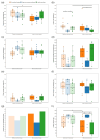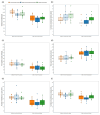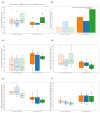Lockbox enrichment facilitates manipulative and cognitive activities for mice
- PMID: 39257918
- PMCID: PMC11384198
- DOI: 10.12688/openreseurope.17624.2
Lockbox enrichment facilitates manipulative and cognitive activities for mice
Abstract
Background: Due to the lack of complexity and variety of stimuli, conventional housing conditions of laboratory mice do not allow these animals to fully express their behavioral repertoire, including manipulative and cognitive activities. Therefore, we designed mechanical puzzles, so-called lockboxes, for mice that can be provided in their home cages. We investigated the impact of the lockbox enrichment on their phenotype and affective state when compared to conventional housing (CH) and super-environmental enrichment (SEE).
Methods: Young adult female C57BL/6JCrl mice were examined before and after 2-month exposure to the different types of enrichment in a phenotyping test battery, including tests for trait and state anxiety-related behavior, calorimetric measurements, body weight measurements, the analysis of stress hormone metabolite concentrations, and sequential problem-solving abilities with a novel lockbox. At the end of the study, adrenal gland weights were determined and pathohistological evaluation was performed. For all continuous variables, the relative variability was calculated.
Results: While the different types of enrichment affected trait anxiety-related behavior, neither state anxiety-related behavior nor physiological variables (i.e., bodyweight, resting metabolic rate, stress hormone metabolite concentrations, adrenal gland weights) were influenced. LE improved sequential problem-solving (i.e., solving novel lockboxes) when compared to SEE. Regardless of the housing condition, the relative variability increased in most variables over time, although the coefficient of variation decreased for some variables, especially in animals with access to LE. There was no evidence of toxicopathological effects associated with the material from which the lockboxes were made.
Conclusions: All lockboxes are available as open-source tool. LE revealed beneficial effects on the affective state of laboratory mice and their performance in solving novel lockboxes. Neither relevant phenotype of the mice nor reproducibility of the data were compromised by LE, similar to SEE. The lockboxes may also be used as novel approach for assessing cognition in mice.
Keywords: Mice; animal welfare; cognition; enrichment; home cage; phenotyping; refinement; sequential problem-solving.
Copyright: © 2024 Hohlbaum K et al.
Conflict of interest statement
No competing interests were disclosed.
Figures









Similar articles
-
Effects of Cage Enrichment on Behavior, Welfare and Outcome Variability in Female Mice.Front Behav Neurosci. 2018 Oct 26;12:232. doi: 10.3389/fnbeh.2018.00232. eCollection 2018. Front Behav Neurosci. 2018. PMID: 30416435 Free PMC article.
-
Impact of environmental enrichment in mice. 1: effect of housing conditions on body weight, organ weights and haematology in different strains.Lab Anim. 2002 Oct;36(4):411-9. doi: 10.1258/002367702320389071. Lab Anim. 2002. PMID: 12396284
-
Effects of environmental enrichment on males of a docile inbred strain of mice.Physiol Behav. 2004 Oct 15;82(5):765-76. doi: 10.1016/j.physbeh.2004.05.009. Physiol Behav. 2004. PMID: 15451640
-
Challenges and advanced concepts for the assessment of learning and memory function in mice.Front Behav Neurosci. 2023 Sep 21;17:1230082. doi: 10.3389/fnbeh.2023.1230082. eCollection 2023. Front Behav Neurosci. 2023. PMID: 37809039 Free PMC article. Review.
-
A systematic review of the development and application of home cage monitoring in laboratory mice and rats.BMC Biol. 2023 Nov 13;21(1):256. doi: 10.1186/s12915-023-01751-7. BMC Biol. 2023. PMID: 37953247 Free PMC article.
References
-
- Directive 2010/63/EU of the European Parliament and of the council of 22 September 2010 on the protection of animals used for scientific purposes. Official Journal of the European Union ABI. L276/33-L276/79,2010. Reference Source
LinkOut - more resources
Full Text Sources
